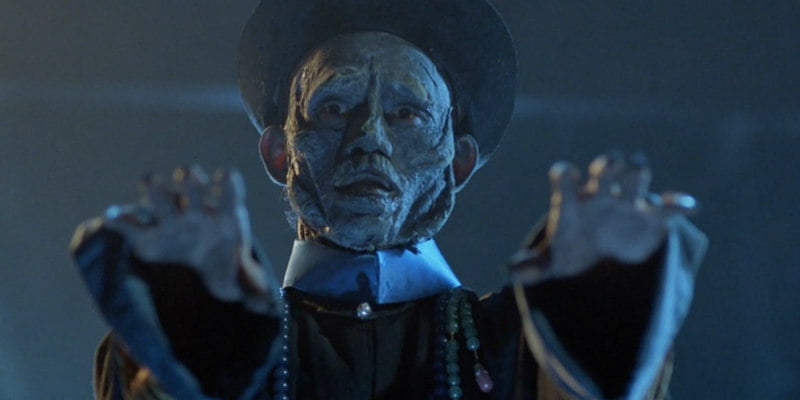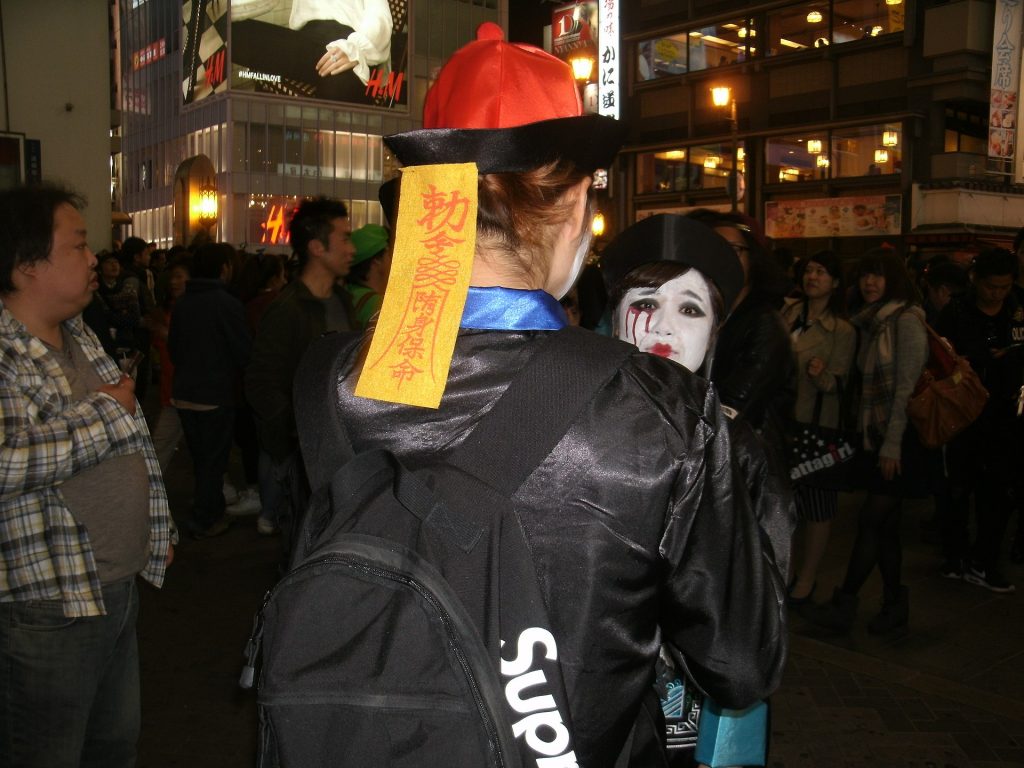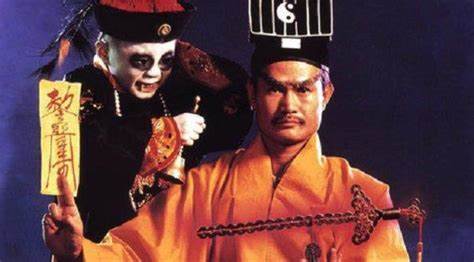Jiangshi (僵尸, literally “the stiff corpse”) is a type of a vampiric monster present in the Chinese folklore. Since it is known to be a dead creature that sucks out the living force of humans, it can be regarded as a Chinese equivalent of the legendary Western vampire or zombie. Jiangshi were believed to once be people who died in a violent or unnatural way, or whose soul did not find rest at the time of death. Their key features are very similar to western vampires.
Key characteristics of jiangshi:
- A very pale skin: since they cannot bear to come into contact with sunlight, they tend to appear only at night. Jiangshi is also presented as having a green and white skin, due to a fungus that grows on corpses.
- A body that doesn’t decompose: their hair and nails continue to grow as if they were alive.
- A long white hair.
- They are completely blind, but detect people by breathing (therefore, heavy breathing at their presence is not recommendable).
- Their appearance varies from a perfectly normal body to a horrible rotting corpse (depending on what movie you are watching).
- They are blood drinkers: this characteristic shows the influence of the Western vampire myth; traditionally, jiangshi were believed to extract the living force (氣, qi) out of living humans.
- A person bitten by a jiangshi gradually becomes one as well.

In popular iconography, the Chinese zombies usually wear funeral robes from the times of Qing Dynasty, which in Western popular culture is frequently interpreted as “the image of the Mandarin”. If you are familiar with the story of Fu Manchu, you will naturally see the clue. Fu Manchu is a character in a series of novels by British novelist Sax Romer, who portrayed this Chinese official as the evilest being in the world. The “image of the Mandarin” comes from the observation and imagination of the Qing people by the British in the 19th century. The “official uniform of the Qing Dynasty” commonly worn by jiangshi is also a symbol of the late imperial era in the Chinese history.
How to defend yourself from a jiangshi?
Taoist monks can stop a jiangshi through various spells. However, there are also other more efficient methods known in the Chinese folklore. Among the most iconic ones is writing a spell with chicken blood on a yellow slit of paper and placing it on the forehead of the monster, what stops it from moving. They are also afraid of mirrors, peach wood and jujube seeds. Holding an 8-sided mirror can also reflect the light that may scare the jiangshi away.

The origin of jiangshi
The origin of the legends about these terrifying creatures probably comes from the folkloric tradition of “traveling corpses”. In the past, the members of low-income families whose friends and/or relatives had died in distant places couldn’t afford to pay for the transfer fees of their dead. Therefore, they would instead hire Taoist priests to transport the corpses back home. The priests moved the corpses only at night and rang bells to warn off passing villagers. This practice was very popular in Xiangxi, where many people had left their homes in search for better job opportunities. After death, their bodies were returned to their homes, as it was believed that their souls would feel homesick if they were buried in a distant place. Because the corpses were carried on bamboo beds with the canes shaking as the priests walked, it gave the impression that the body jumped in rhythm with the steps of these priests.

In 18th century China, a Qing dynasty scholar Ji Xiaolan wrote that there were two types of jiangshi: a recently deceased person who suddenly returned to life, or a corpse that was buried for a very long time but did not decompose. Among the causes of such supernatural phenomenon Ji Xiaolan listed, among others, a violent death or suicide, a spirit possession of a dead body, an absorption of sufficient qi (life energy) by the body so the dead was back to life or the person not being actually buried even though the funeral had already taken place.
Chinese zombie in popular art: the history of the Jiangshi horror – comedy
Since the jiangshi were already being portrayed in the Chinese theaters, the figure of the monster served as an inspiration for many Asian novels and movies since the silent film era. In the 1980s, the East Asian horror cinema was seeking to change its terrifying image into something more comic. It led to launching productions that mixed horror, comedy and martial arts. Producing movies about jiangshi was especially popular in Hong Kong. The 1980s and 1990s were the golden age of Hong Kong films. In 1985, “Mr. Zombie”, directed by Liu Guanwei, received 20 million HKD in the box office, ranking seventh in that year. In the next five years, more than 100 similar films were shot in Hong Kong and Taiwan. The classic image of these vampire-zombies in Hong Kong movies includes the official Mandarin uniform, a rigid body, no thoughts or feelings, long nails and a pair of fangs, fear of sunlight and a crave for fresh blood. It shows that Hong Kong filmmakers integrated Chinese and Western cultures in their image of jiangshi.
However, already in 1987, the “zombie movie” craze had begun to cool down. In the 1990s, the box office of jiangshi movies continued to decline, and the glory of “Mr. Zombie” was never reproduced. With the arrival of digital visual effects, the genre experienced a renaissance in the 2000s, with slightly more substantial films, and increasingly, the figure of the “Chinese Zombie” was distorted and integrated into the manga, anime and video games. Therefore, there is no more “typical” jiangshi anymore: each artist is free to implement his or her own vision of this terrific monster.

Interested in more facts about the Chinese culture? Check out some of our articles below:


